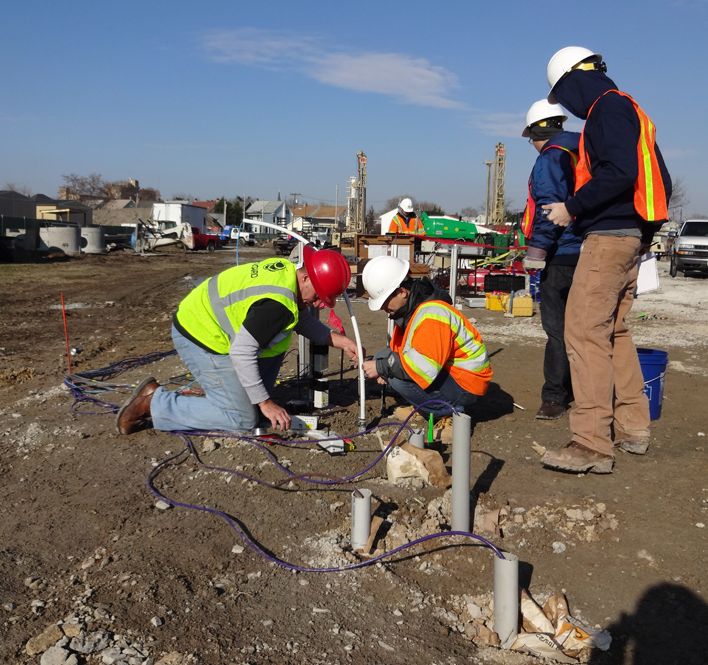How Consulting Engineers Enhance Geotechnical Design Projects: Insights Into Their Experience, Methods, and Collaborative Approaches
Consulting engineers are crucial in enhancing geotechnical design tasks, applying their specialized understanding to browse the complexities of subsurface conditions. Their collective strategies foster communication among varied project stakeholders, ultimately forming the task's trajectory.
Role of Consulting Engineers
The know-how of consulting engineers in geotechnical engineering is basic to the effective execution of building jobs. These specialists play a pivotal role in evaluating soil and rock residential properties, which are critical elements influencing style and building choices. By performing thorough site investigations, speaking with engineers gather vital information that notifies the style procedure, making sure jobs are constructed on secure and ideal ground.
Consulting designers likewise supply vital understandings right into danger administration (geotechnical geologist). They determine potential geotechnical risks, such as landslides, soil liquefaction, and negotiation concerns, making it possible for stakeholders to apply efficient mitigation techniques. Their competence aids in optimizing foundation layouts, which can bring about considerable expense savings and boosted safety and security
Moreover, seeking advice from engineers act as an essential web link between task owners, designers, and service providers. Their capacity to convert complicated geotechnical information into actionable referrals promotes collaboration and facilitates informed decision-making throughout the task lifecycle. This multidisciplinary method not just improves project performance yet additionally guarantees compliance with regulative standards and ideal methods.
Key Methodologies in Geotechnical Design

One primary approach is site examination, which entails carrying out area examinations and research laboratory evaluations to gather data on subsurface conditions. Strategies such as Criterion Penetration Testing (SPT) and Cone Penetration Testing (CPT) are widely utilized to examine soil stratigraphy and strength. Additionally, geophysical methods, including seismic and electrical resistivity surveys, offer non-invasive ways to analyze subsurface characteristics.
Another crucial approach is numerical modeling, which enables engineers to replicate different situations and forecast just how soil-structure communications will certainly behave under different loading conditions. Finite Element Evaluation (FEA) is an usual technique utilized in this context.
Moreover, the layout of structures, preserving frameworks, and earthworks depends heavily on these methodologies - geotechnical geologist. By incorporating advanced analytical tools with area information, seeking advice from engineers can develop tailored services that address details task difficulties, ultimately adding to the security and security of construction projects
Relevance of Soil Analysis
Soil analysis functions as a foundational component in geotechnical engineering, giving vital insights right into the physical and chemical residential or commercial properties of soil required for reliable building and construction preparation. Recognizing dirt attributes is crucial for establishing its load-bearing capacity, drain actions, and capacity for negotiation or instability. Detailed soil examinations, including sampling and research laboratory testing, assistance recognize parameters such as soil kind, dampness content, density, and shear toughness.
These analyses inform the choice of ideal construction methods and products, inevitably influencing job security and long life. Cohesive soils may require different foundation styles contrasted to granular dirts, demanding customized engineering solutions. Soil evaluation help in recognizing impurities that can posture threats to human wellness or the setting, permitting for the advancement of mitigation techniques.
Integrating soil analysis right into the onset of job advancement helps to reduce unexpected challenges, ensuring that designers can prepare for and attend to prospective issues prior to they rise. By developing an extensive understanding of the site problems, getting in touch with designers can enhance design performance and minimize expenses, thus enhancing the total success of geotechnical engineering projects.
Joint Techniques in Projects
Effective geotechnical jobs typically hinge on joint methods that combine varied experience from different techniques. Reliable partnership among speaking with designers, geologists, ecological scientists, and construction experts is essential for addressing complicated challenges and enhancing project results. By leveraging the unique abilities and knowledge of each employee, jobs can profit from a holistic understanding of the website conditions, regulative click here for more needs, and engineering restrictions.
Regular communication and interdisciplinary conferences facilitate the sharing of understandings and cultivate a culture of team effort. These joint efforts allow the recognition of potential dangers early in the task lifecycle, permitting timely reduction strategies. Furthermore, including responses from stakeholders, including regional areas and governing agencies, guarantees that all viewpoints are considered, enhancing job approval and conformity.
Furthermore, the combination of innovative modern technologies, such as Geographic Details Equipment (GIS) and Structure Information Modeling (BIM), further enhances collaboration. These tools permit the real-time sharing of information and visualization of geotechnical problems, advertising educated decision-making. Inevitably, a joint technique not just enhances job implementation however likewise lays the foundation for innovative hop over to these guys solutions to complex geotechnical design obstacles.
Influence on Task Results

Consulting designers employ sophisticated methodologies such as threat assessment and anticipating modeling, which enhance the precision of task forecasts. Their capacity to integrate ingenious technologies, like geotechnical instrumentation and information analytics, further fine-tunes the layout and construction procedures. Therefore, projects experience boosted efficiency, decreased prices, and minimized hold-ups.
Furthermore, cultivating effective communication and cooperation amongst team members boosts problem-solving abilities. When difficulties emerge, a united front enables for speedy recognition of solutions, avoiding prospective troubles. Ultimately, the collaborative efforts of getting in touch with designers see contribute to higher quality results, making sure that tasks fulfill both regulatory standards and client expectations.
Conclusion
